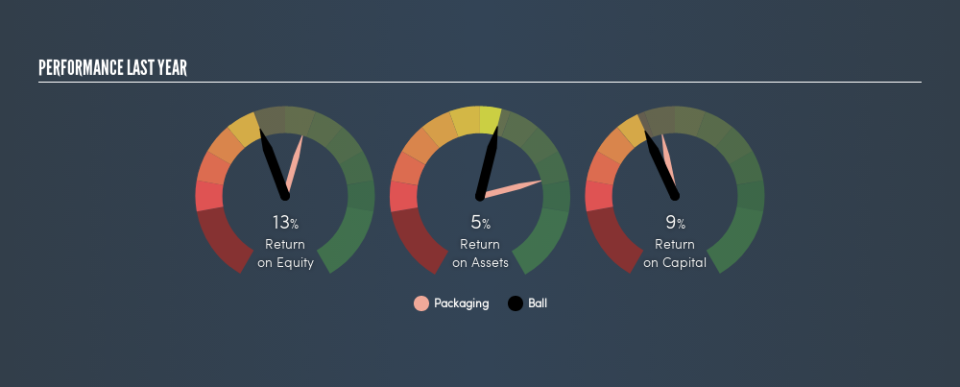Why We’re Not Impressed By Ball Corporation’s (NYSE:BLL) 9.0% ROCE

Want to participate in a research study? Help shape the future of investing tools and earn a $60 gift card!
Today we'll evaluate Ball Corporation (NYSE:BLL) to determine whether it could have potential as an investment idea. Specifically, we're going to calculate its Return On Capital Employed (ROCE), in the hopes of getting some insight into the business.
First, we'll go over how we calculate ROCE. Second, we'll look at its ROCE compared to similar companies. Last but not least, we'll look at what impact its current liabilities have on its ROCE.
Return On Capital Employed (ROCE): What is it?
ROCE is a measure of a company's yearly pre-tax profit (its return), relative to the capital employed in the business. In general, businesses with a higher ROCE are usually better quality. Ultimately, it is a useful but imperfect metric. Renowned investment researcher Michael Mauboussin has suggested that a high ROCE can indicate that 'one dollar invested in the company generates value of more than one dollar'.
So, How Do We Calculate ROCE?
The formula for calculating the return on capital employed is:
Return on Capital Employed = Earnings Before Interest and Tax (EBIT) ÷ (Total Assets - Current Liabilities)
Or for Ball:
0.09 = US$1.1b ÷ (US$17b - US$4.1b) (Based on the trailing twelve months to December 2018.)
Therefore, Ball has an ROCE of 9.0%.
Check out our latest analysis for Ball
Does Ball Have A Good ROCE?
One way to assess ROCE is to compare similar companies. In this analysis, Ball's ROCE appears meaningfully below the 12% average reported by the Packaging industry. This performance is not ideal, as it suggests the company may not be deploying its capital as effectively as some competitors. Setting aside the industry comparison for now, Ball's ROCE is mediocre in absolute terms, considering the risk of investing in stocks versus the safety of a bank account. It is possible that there are more rewarding investments out there.
When considering ROCE, bear in mind that it reflects the past and does not necessarily predict the future. ROCE can be misleading for companies in cyclical industries, with returns looking impressive during the boom times, but very weak during the busts. This is because ROCE only looks at one year, instead of considering returns across a whole cycle. Since the future is so important for investors, you should check out our free report on analyst forecasts for Ball.
What Are Current Liabilities, And How Do They Affect Ball's ROCE?
Current liabilities are short term bills and invoices that need to be paid in 12 months or less. Due to the way ROCE is calculated, a high level of current liabilities makes a company look as though it has less capital employed, and thus can (sometimes unfairly) boost the ROCE. To counteract this, we check if a company has high current liabilities, relative to its total assets.
Ball has total liabilities of US$4.1b and total assets of US$17b. As a result, its current liabilities are equal to approximately 25% of its total assets. This is a modest level of current liabilities, which would only have a small effect on ROCE.
The Bottom Line On Ball's ROCE
With that in mind, we're not overly impressed with Ball's ROCE, so it may not be the most appealing prospect. You might be able to find a better buy than Ball. If you want a selection of possible winners, check out this free list of interesting companies that trade on a P/E below 20 (but have proven they can grow earnings).
For those who like to find winning investments this free list of growing companies with recent insider purchasing, could be just the ticket.
We aim to bring you long-term focused research analysis driven by fundamental data. Note that our analysis may not factor in the latest price-sensitive company announcements or qualitative material.
If you spot an error that warrants correction, please contact the editor at editorial-team@simplywallst.com. This article by Simply Wall St is general in nature. It does not constitute a recommendation to buy or sell any stock, and does not take account of your objectives, or your financial situation. Simply Wall St has no position in the stocks mentioned. Thank you for reading.

